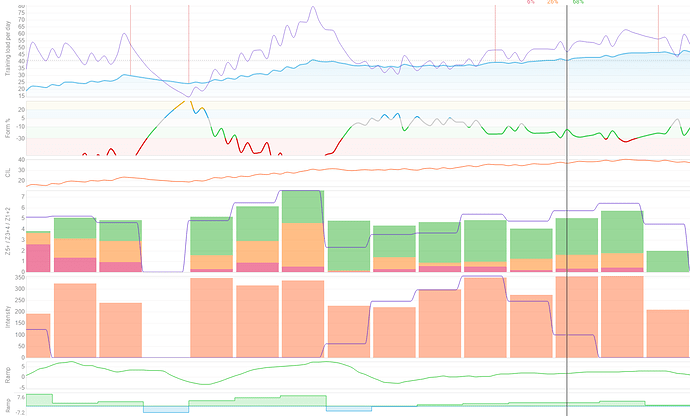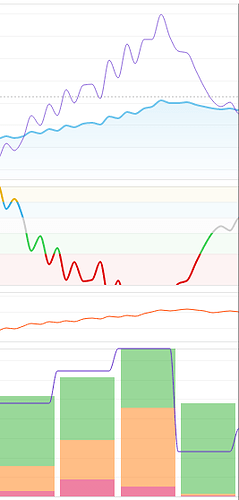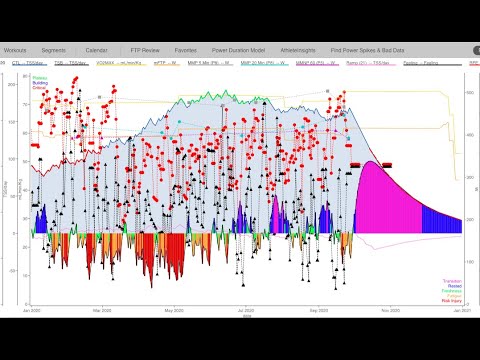Yep, got that. Again, not really asking about following or building the plan but leading up to it. If I’m too fresh I’ll have more of a chance to overtrain and blow up, if I’m too tired the same may happen. I’m aiming to start the plan in such a way where my form will spend as much time in the optimal zone as possible
I’ve experimented quite a lot this season self-coached, and one piece of advise I would give you is not to chase a fitness score. Following a taper, a race and a quieter recovery week, I have seen a huge boost in my numbers. In hindsight I would have had more substantial rest periods, but I kept volume high to ensure my fitness score didn’t drop too much.
Fitness comes from recovery not from training, so just because your fitness score is dropping it doesn’t mean your actual fitness is.
I think that is an excellent point and I have misinterpreted the “fitness” score as well. It is more a “training load tolerance” score than a measure/predictor of your “fitness”. I suspect there is a correlation between training load tolerance and your fitness potential, not your actual fitness?
That is also my doubt.
Once no all TSS are built equal I wonder how to plan without taking CTL etc in account when doing intervals at high intensities where load is somewhat low but are very demanding.
We are still missing a metric for that, I think.
Regards,
Hello,
I have also been working on this topic for some time. When training outside, the training control via CTL works very well and gives me a good feedback of my load and recovery.
When training indoors in winter on the smarttrainer, it looks completely different. Because the training stimuli from shorter and harder units via CTL are only very slightly represented here, a different metric was necessary. I was able to display the desired representation via CIL. Here the IF is used instead of the TSS as indicator.
Especially with short and hard VO2max units the CTL does not show the performed load. The result is that the fitness stagnates or even develops negatively and you will be tempted to increase the volume and the load further, which inevitably leads to overloading. I had to make this experience myself last year.
With the additional observation of the CIL I can recognize the actual load during winter training indoors much better and can plan and control the loads more precisely.
Sorry for the strange English but this explanation was not possible without a translator. 
Wow, I had never heard about CIL before. I like the chart very much!
Thank you,
Yes, I agree with the conclusion that trainer hours don’t get reflected that well in your Fitness charts. Still struggling to make sure I don’t overtrain myself on the trainer, since I still try to keep my Fitness-level at least… level… 
I feel the same way and at the beginning of the indoor winter season I made the same mistake as last year and started way too hard. On top of that, I did some long rides outside on beautiful autumn days. Both together was too much and I was weaker right at the start than before.
You can see that very well in my chart during this phase. I needed to take a break with a very light load to recover.
Since I have installed the charts intensity together with load and CIL, it is much easier for me to classify the weeks and to see the load at low time.
What has also been a step forward for me is the total of RPE per week (along with the intensity chart). I enter RPE for each workout and the total gives me good feedback on my subjective feeling of exertion. I think this value is not unimportant and helps to recognise if the increase in intensity or load was too high or too low.
Indoors is really not comparable to outdoors. 
Could you shed light on what metric you exactly trace at the moment?
For me personally, I can see that my CIL has increased from roughly 30 during the summermonths (~150-200 km’s of outdoor riding, some intervals, mostly just riding with friends, 1.5-4 hours per ride) to 40 at the moment (indoors, mainly HIIT and other hard rides of 1hr).
During the summer, my Form (at least the chart) was steadily increasing to a peak of 70 (% of Fitness).
Currently I’m struggling to keep it around 45, but I feel I’m on the edge of overtraining (no worries, I’ll promise to take care of myself  )
)
To be honest, I currently try to ignore the development of fitness (I’m talking about the chart). The ambition to develop my fitness curve in the winter compared to the summer drove me into overtraining last year - it was simply not possible to achieve anything close to a similar development without constantly driving myself completely empty on my trainer.
In the current phase, I’m concentrating much more on the quality of the training, which is not comparable to the rides with friends in the summer.
My goal is currently:
- to do targeted polarised training according to the 80/20 method to improve my anaerobic abilities (please read this article: Polarised training suggestions)
- to train in a very structured way, which I don’t do so well in the summer with lots of pleasure rides.
Reflect on yourself please, do you do short hard HIT sessions with friends in the summer - I don’t think so. I feel the same way. Fitness development (I’m talking about the chart again) takes place in a completely different place in the summer, more in the endurance area. Of course, the ability to climb and sprint also improves, but the long rides alone result in a completely different image of load compared to winter training, which would not be possible over the same duration as in summer.
The result is that you have the feeling of stagnating or even losing fitness in winter. Therefore, I compare the summer development to the winter development with the CIL metric, which is also much flatter in the summer because only the IF is taken into account. If we now look at the winter, we see that the winter is not so bad. The IF in winter is sometimes just as high for hard units as in summer for long units.
I would like to give another example: A few days ago I rode a familiar loop outside again. About 70 km and two short hills with 750 metres of altitude each that I know very well and where I also know my performance and subjective feeling well.
On the ride I had to fight hard but not harder than in summer and it was freezing cold. It was unusual to ride a “real” mountain after a few weeks of pure indoor training. I thought: What a mess, my good form from the summer when I flew up is gone. But when I got home, I saw that I had achieved a new best time on both climbs.
This showed me again that the development of the fitness chart doesn’t really map to actual fitness. I think you have to move away from comparing summer and winter fitness development. It probably works better to look at training periods and their development separately.
I think you have to use al the metrics as a tool, not as a hard fact. The metrics do not show how good you slept, do you have a busy week on your job and do you have stress etc. In the winter most riders do a lot of gym work. Thats make you tired, but PMC do not include that workout. Al thats things affected your recovery and how much you are able to do a hard workout.
So use the metrics as a tool out the toolbox and use your feeling and mind. PMC is to limited to get a exactly good number.
For example when you are in a race season your PMC will stagnate because through racing your volume is going down. But your fitness isnt going down. So do not get blinded on your metrics.
Very interesting article for this topic.
Where in intervals.icu you find CIL ? How to put it in the chart ? What CIL stand for ?
Kind Regards Swen
On the Fitness Page you can choose CIL. It is calculated in a similar way like CTL (exponential average). An explanation can be found here: https://www.trainingpeaks.com/blog/chronic-intensity-load-a-new-measure-of-training-load-based-on-intensity-factor/
I don’t know how to use it, but it should help to track the intensity (“not all TSS is created equally”).
I see CIL as replacement for CTL for indoor season when I do more high intensity training on trainer compare to summer when I ride outdoors usually long and slow.
If the charts composed of the data we’re capturing here were 100% accurate, there would be no need to race. Competitors could just compare charts on any given day and the one with the best #s wins. Fortunately, real life isn’t like that.
I’m a bit of a geek about these charts and am honestly smitten. Even still, I do take all the charts with a grain of salt. That said, I have definitely altered my training plan based on what I was seeing in the fitness chart AND how I was feeling (or anticipate feeling) in real life. Being 54, this generally involves inserting more recovery periods or reducing load during planned recovery weeks. In this regard, I’ve found the fitness charts to be very helpful.
Curiously, after doing just that — adjusting my TR SSB 1&2 blocks to be 7 weeks each with an extra recovery week after week 3 — my forecasted fitness for my A event in late June holds steady. I suppose I’ll just have to wait and see how it plays out, but there’s no sense in not being realistic about my recovery needs just because I want to hitch my CTL or CIL or any other # to my ego.
Jim_Ahearne - My gut filing about whether I am over-trained or under-trained does not work well. My first symptoms for over-training are morning heart rate racing or injury . It’s my first winter season with fitness, fatigue, form algorithm. I hope for it to tell me to rest. I don’t need it to tell me to train more.
As I said here before, you have to learn to listen to your body. A graph dont get tell you when to rest. When you are not a pro, there is more than training on a day. Work, family life, illness etc. Your loadability is not every day or every week the same.
Make everyday morning and every training a RPE, thats the way you can learn to listen to you body. Ask yourself every morning how do you feel. And after every ride give yourself a number about how you feel during the ride and how hard you found the ride. Ask yourself questions give you more information than only CTL/CIL.
If it is properly confirmed CTL / CIL only what you already know.
How are your intensity graph constructed (which values) - are you just adding up the intensity for each session and the rpe - or are you using an average?
And is CIL and the intensity still how you analyze your training?




